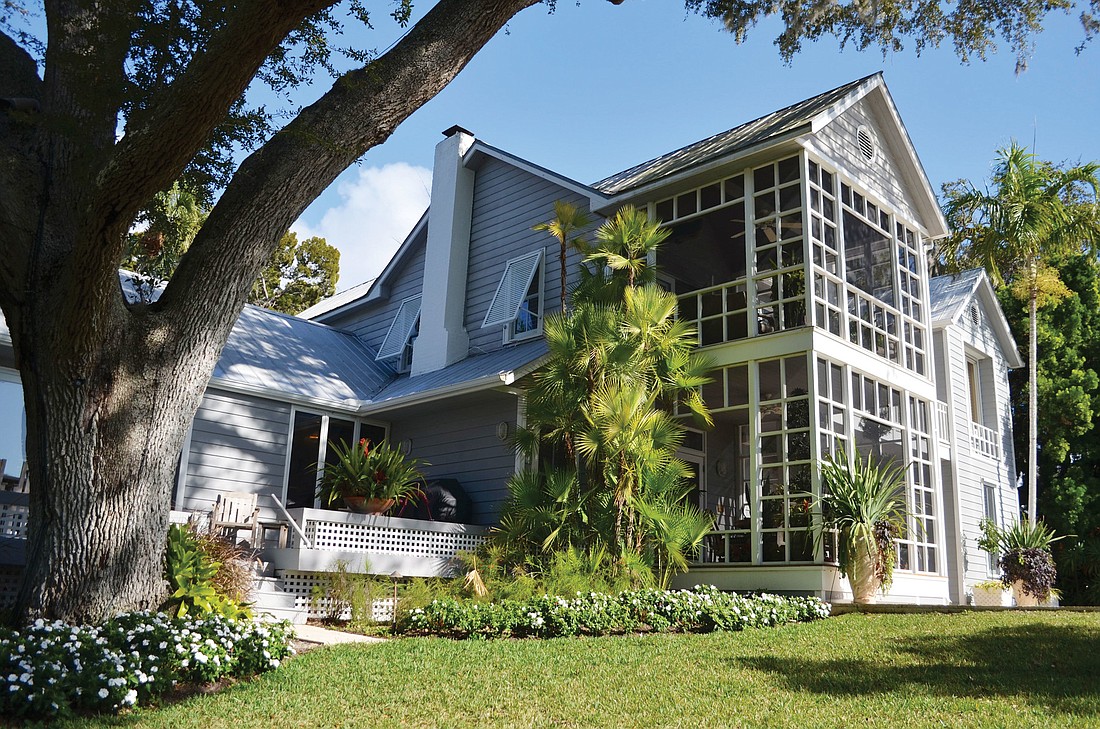- April 17, 2024
-
-
Loading

Loading

He’s one of Sarasota’s leading architects, whose buildings include the iconic high-rise Plymouth Harbor.
She’s one of the town’s leading interior designers, famous for her look of informal glamour and luxury. So, you’d expect their home of 30 years to be something special — and in the case of Frank Smith and Anne Folsom Smith, you’d be right.
It’s one of the oldest houses in town, dating back to 1894. And it has a spectacular location — right on the bay in the Indian Beach neighborhood, with two acres of carefully tended tropical gardens and a green lawn that sweeps down to a view of City Island and New Pass way off in the distance. And, although you would expect great design both inside and out, you might not expect the comfortable but elegant lifestyle it presents — a classic example of the Sarasota way of life.
The Smiths discovered the home back in 1983, when they were recently married and looking for a place of their own. One Sunday afternoon they ventured down a crooked, one-lane road covered by a canopy of giant oaks and discovered the unique piece of property. There was an old house on it, dilapidated and covered in aluminum siding. A man mowing the lawn confirmed that it was indeed for sale; within an hour the Smiths decided to buy it. They had not even been inside, but it didn’t matter. The place was clearly a teardown.
But as the demolition process began, so did second thoughts. An old plank on which the original builder inscribed the date, 1894, was discovered. Further research in the archives in Manatee County — Sarasota was a part of Manatee County back in those days — revealed the home was part of the almost forgotten Connecticut Colony, a group of Northerners who were Sarasota’s first snowbirds.
But the property’s real history goes back much further. For thousands of years, the Calusa Indians considered Indian Beach sacred. Further research revealed an Indian midden on the land.
“The ancient spirits spoke to us,” Frank says. “They said, ‘Don’t disturb the land.’”
So, the Smiths changed their plans. The result is a home that honors its past while living in a comfortable and stylish present.
The Smiths kept the 20-by-30-foot two-story farmhouse and, after extensive renovations, it remains the heart of their home. The original heart pine floors gleam under scattered area rugs; there’s a fireplace in one corner and, over by the stairway, a piano.
“It’s a good place for an old Steinway,” says Frank.
But the Smiths spend most of their time in the family room, which they added during renovations. It’s a large rectangular room, clad in cedar planking, with a fireplace at the north end, set against a wall of windows in a grid pattern — a design element that is used throughout the home.
Against another wall is a large triptych by Syd Solomon, an old friend (he died in 2004) who was, perhaps, Sarasota’s most renowned painter during its “artist colony” heyday. The work was featured in the Solomon retrospective at the Ringling Museum in 1973, and the Smiths bumped the wall out to form an alcove that perfectly framed the painting.
Upstairs, a warren of little rooms was combined to form a large high-ceilinged master bedroom, with another large Solomon painting over the bed.
Frank’s home office, appropriately cluttered with paperwork and books relating to his current architectural projects, is down a short hallway, but Anne has her own space, too. A corner of the master has been reconfigured as a tiny but deluxe library. No bigger than 9 feet square, its walls are lined with the mysteries and thrillers she devours in her spare time. A window seat overlooking the bay provides the perfect spot for reading, and there’s a fireplace for winter afternoons.
The master bath completes the suite, and it is the most glamorous room in the house. The walls and floor are lined with honed marble and the built-in cabinets reflect the sleek look Anne is known for; they feature the grid format found elsewhere in the home. Pieces of art, small sculptures mostly, decorate the bath’s shelves. The entire home is filled with art, most of it by local artists.
There is a small guest room adjacent to the living room downstairs, but most guests — including three children and nine grandchildren — are accommodated in the three outbuildings tucked away behind the house. This way, nothing detracts from the house’s most glorious feature, the beautifully tended lawn that slopes down to a tiny private beach. A modernistic swimming pool — which Frank designed — occupies the top of the slope. Next to it, a woman with her arms outstretched — a sculpture by David Windsor — seems to echo the spirit of the Calusas.
At the north border of the two-acre property, John Wheeler — who designed the landscaping — includes a “secret garden” one can enter through an almost-hidden pathway. Here, in deep shade, bamboo and bromeliads offer a hidden refuge, with delicate cast iron chairs for relaxing. Overhead, an occasional osprey can be seen, flying out to the bay, “looking for his dinner,” as Frank says.
It is hard to imagine a more peaceful home.
“It’s a garden spot in the middle of the city,” Anne says.
But it’s more than that.
It may be the most quintessentially Sarasota home of all. Now marking its 120th anniversary, it looks backward on 2,000 years of local history. And though its origins have been carefully noted and preserved, the way of living it provides is exactly what the town aspires to — beautiful design, informality, family life, local art and the glories of living on the sparkling water of Sarasota Bay.